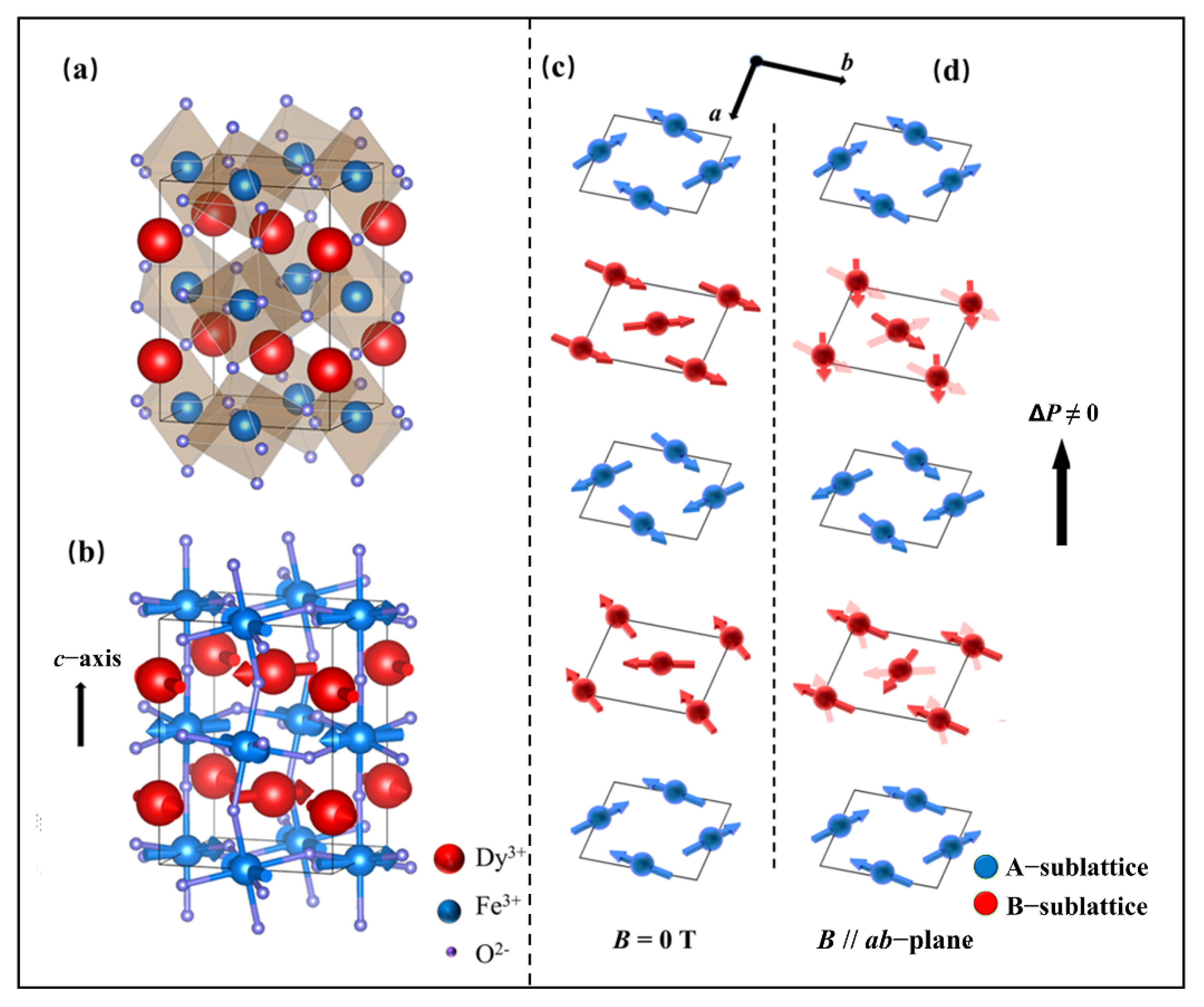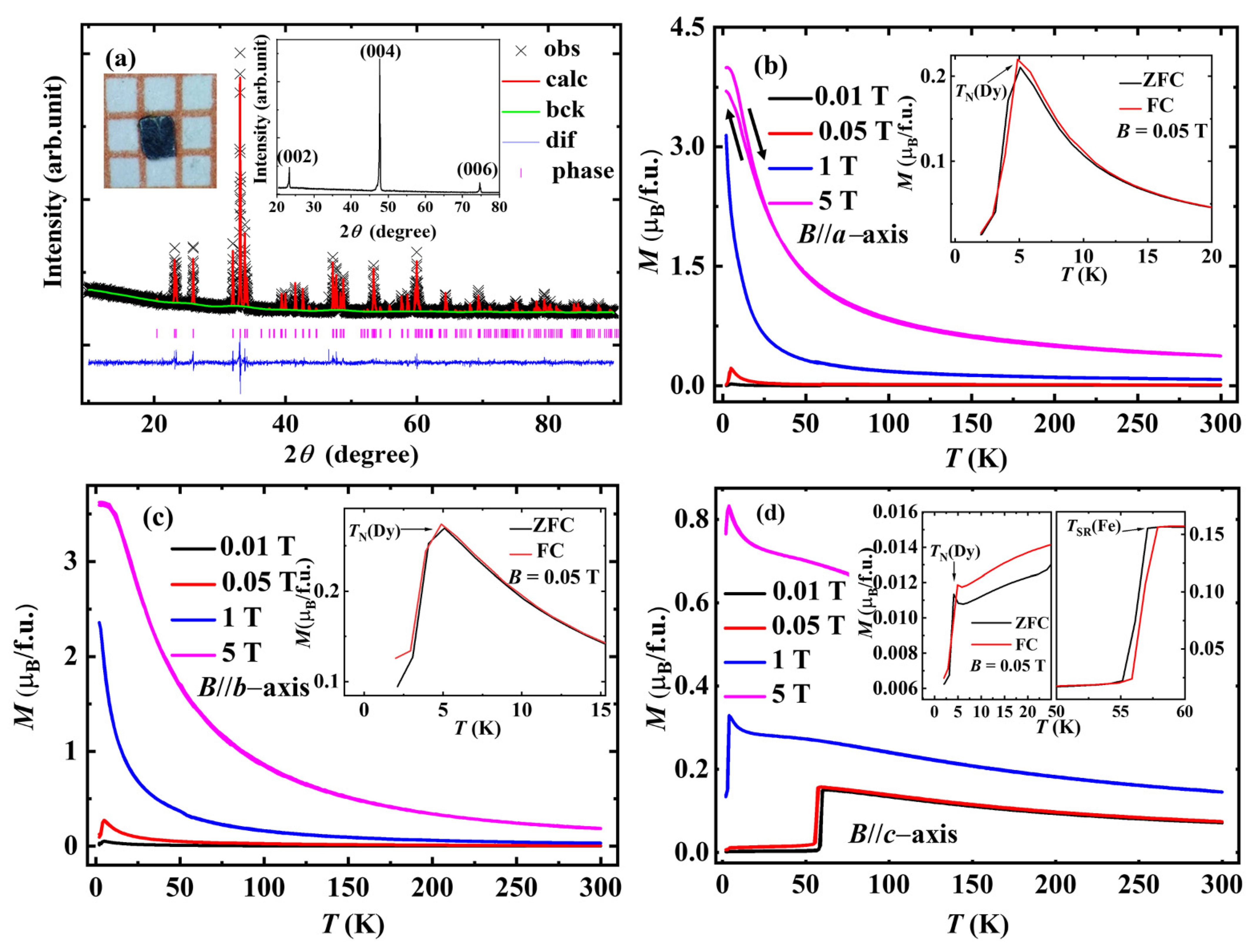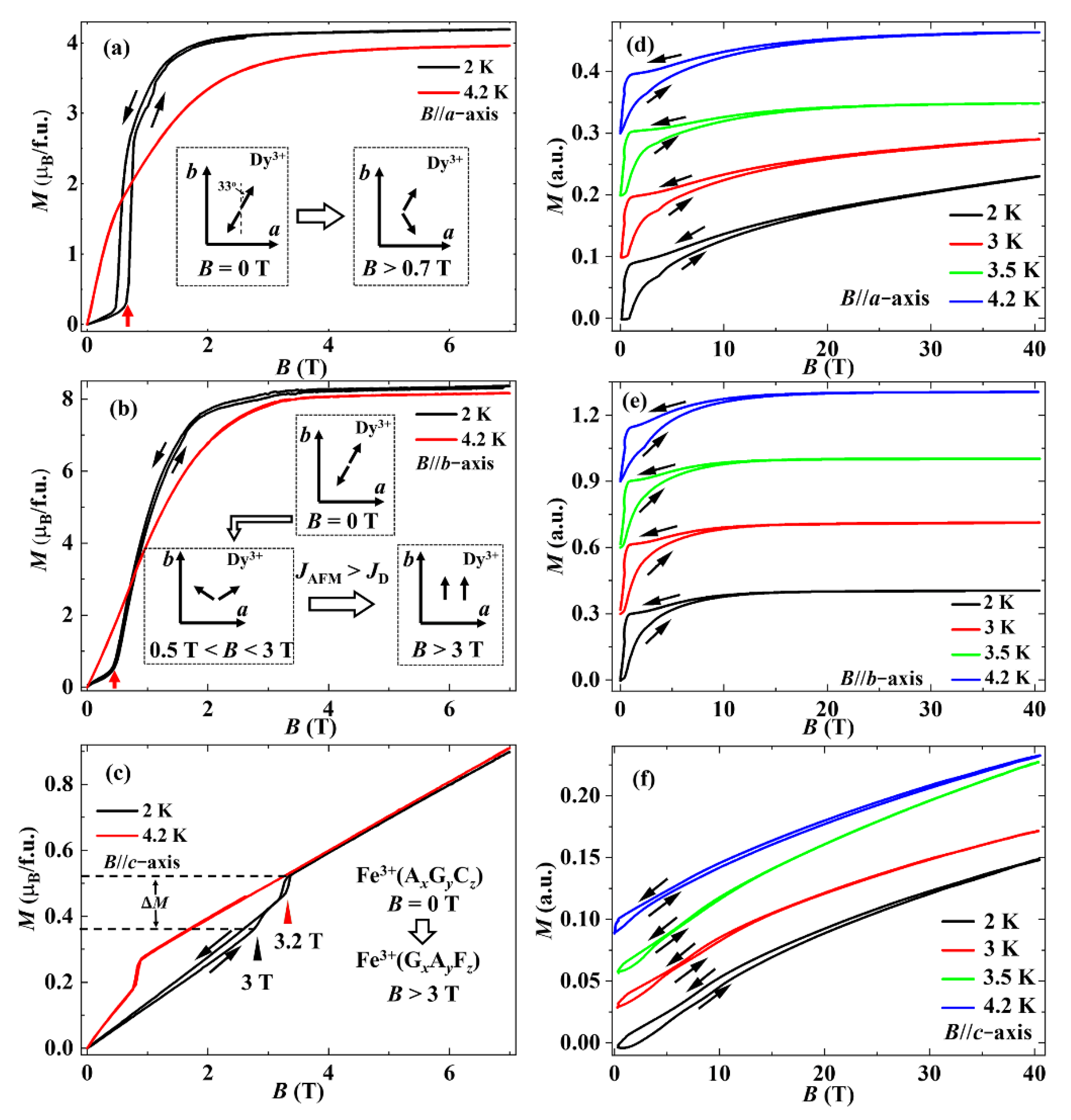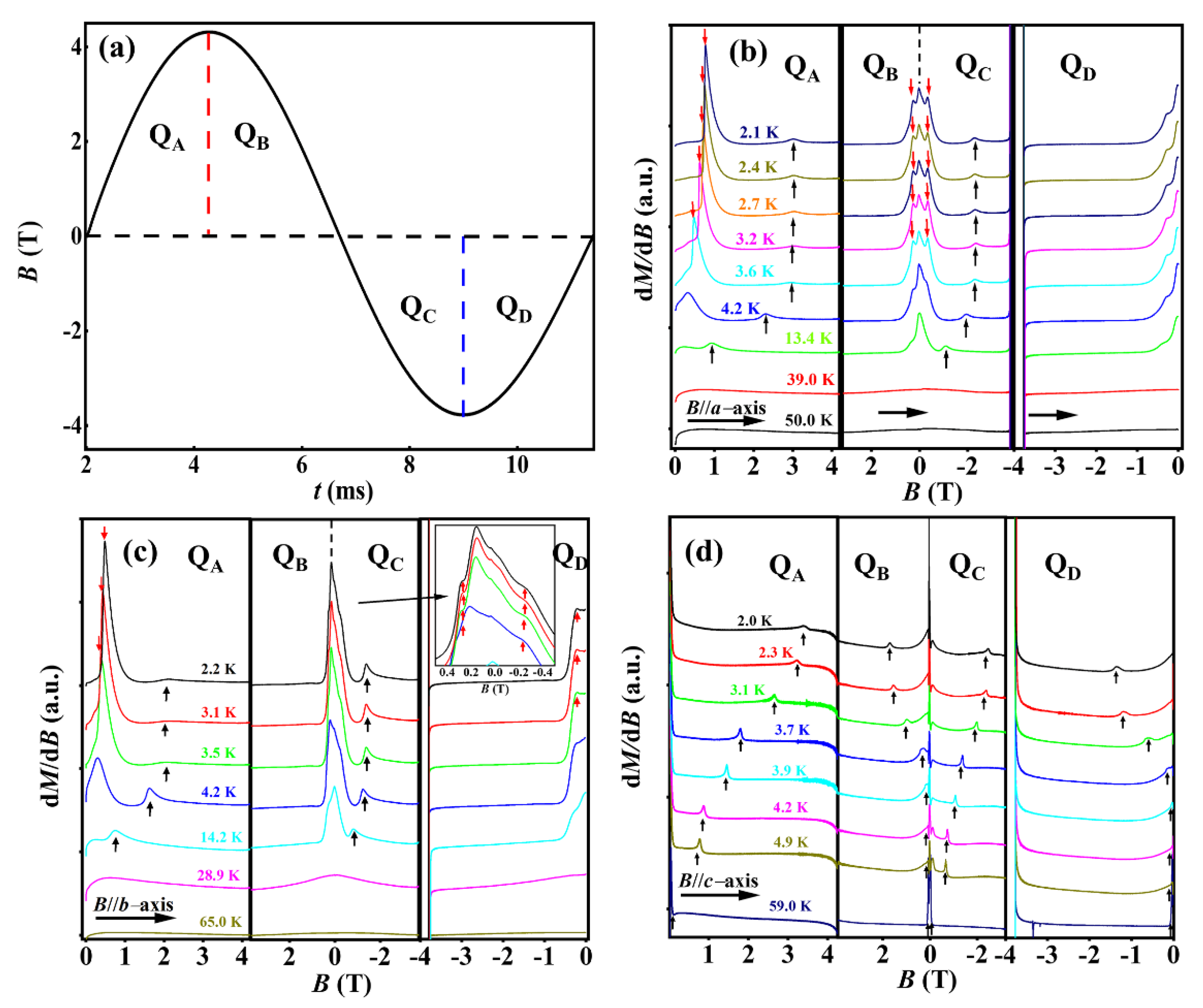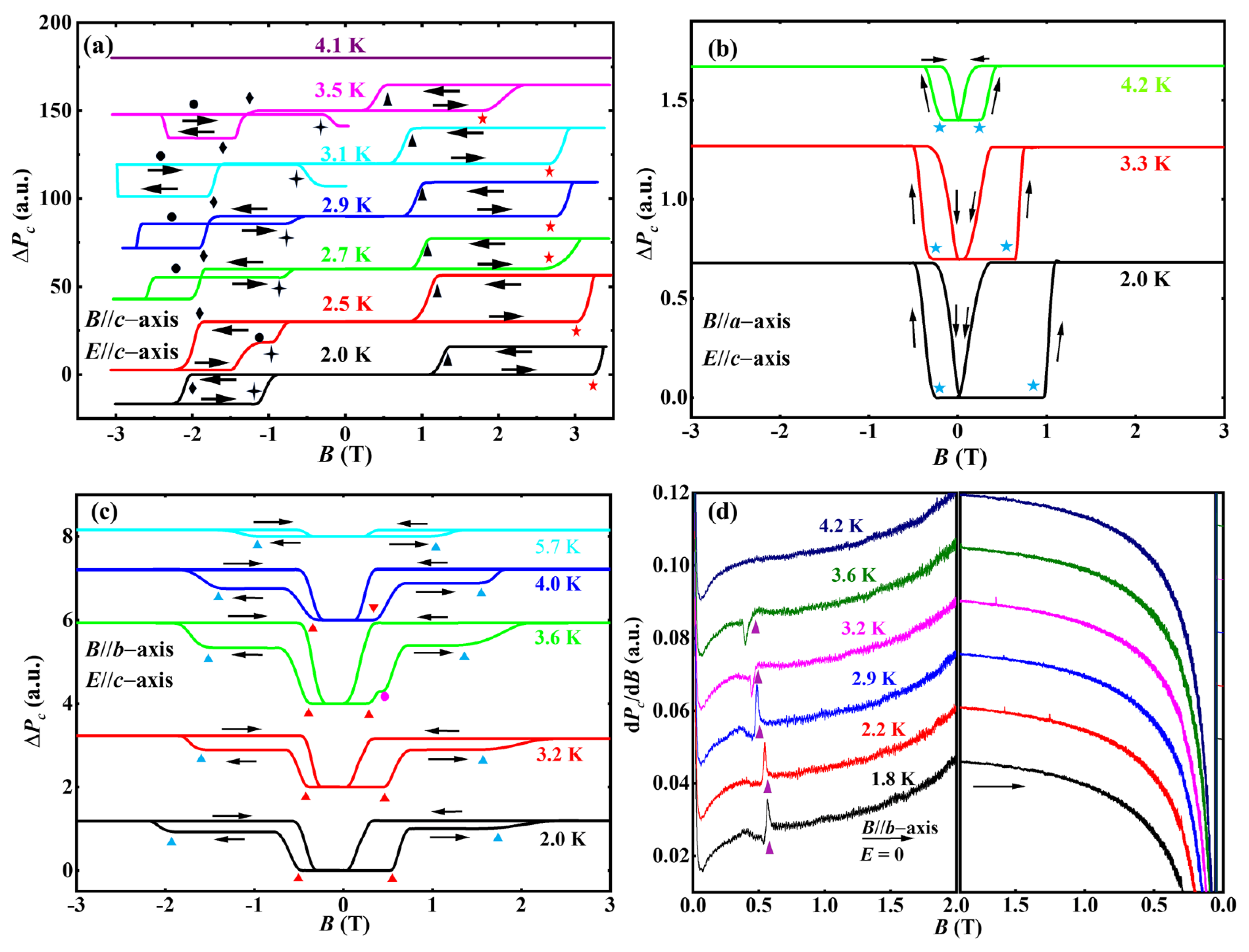1. Introduction
Multiferroic materials [
1,
2,
3,
4,
5,
6,
7], with the coupling of two or more ferroic orders, have been attracting much attention due to their intriguing physics and great application potential. The
Pbnm structured orthoferrites
RFeO
3 (
R = rare earth element) have great potential value for application as magnetoelectric (ME) devices based on the mutual control of magnetization (
M) and electric polarization (
P) [
8,
9,
10,
11]. For example, at lower temperatures, the application of a large critical magnetic field along the
c-axis induces a multiferroic (weakly ferromagnetic of Fe
3+-sublattice and ferroelectric) state in DyFeO
3, and the magnetic field induced
P results from the movement of the Dy
3+ ions toward the Fe
3+ ions and backward, corresponding to the exchange striction [
12]. The ME coupling and
P are decided by the spin configurations of both Fe
3+ and Dy
3+ ions. In DyFeO
3, Fe
3+ ions (
S = 5/2) exhibit the G
xA
yF
z (magnetic configuration in Bertaut’s notation below its Néel temperature of the Fe
3+-sublattice
TN(Fe) = 650 K) [
13,
14,
15,
16], in which the main component of the magnetic moment of Fe
3+ ions lies along the
a-axis, and due to the Dzyaloshinskii–Moriya interaction (DMI), a small fraction of the moment is canted along the
c-axis, causing weak ferromagnetism (wFM) in the material [
17]. With decreasing temperature, the spin-reorientation (Morin) transition occurs at
TSR (in the range of about 35~70 K [
18,
19,
20,
21]), where the magnetic configuration of Fe
3+ ions changes from G
xA
yF
z to A
xG
yC
z, and then the wFM disappears. Below the antiferromagnetic (AFM) ordering temperature of the Dy
3+-sublattice
TN(Dy) = 4.2 K, the Dy
3+ magnetic configuration is G
xA
y [
22,
23] with the Ising axis deviation of about 33° from the
b-axis. When a magnetic field (higher than about 3 T) is applied along the
c-axis below
TSR, the spin configuration of the Fe
3+-sublattice is driven to G
xA
yF
z again [
4].
For spin-driven ferroelectricity, there are mainly three types of microscopic mechanism models, i.e., the inverse Dzyaloshinskii–Moriya (IDM) mechanism [
24], spin-dependent
p-
d hybridization model [
25], and exchange striction model [
26,
27], for explaining ME behaviors. According to these models, the emergence of ferroelectricity is hardly understood only by the local spin arrangement, since the symmetry of the crystal structure needs to be considered. In DyFeO
3, below
TN(Dy), the
Pc (the direction of
P is parallel to the
c-axis) can be induced when the magnetic fields (higher than 2.4 T at 3.0 K [
4]) are applied along the
c-axis. However, the ME behaviors in DyFeO
3, i.e., the
Pc is induced with the magnetic fields along other crystal axes, remain to be further understood. Moreover, some abnormal behaviors have been observed. For example, a small
P drop was observed on the
P-
H curve at
BC(Fe) [
4]. Abnormal heat transport was measured, and a Fe
III state (a metastable phase) was speculated [
18]. These abnormal behaviors indicate that there may be complex and delicate magnetic interactions in ME behaviors, such as the competition between the anisotropic energy of the Dy
3+-sublattice, the coupling energy between the Dy
3+ and Fe
3+-sublattices, and Zeeman energy [
28].
In DyFeO
3, when the magnetic field is in the
ab plane, ME coupling with smaller critical fields of 0.8 T (
a-axis) and 0.5 T (
b-axis) is triggered. Inspired by these lower critical magnetic fields, we revisited the structure of DyFeO
3, in which two AFM sublattices (the Fe
3+- and Dy
3+-sublattices) are nesting with each other (see
Figure 1a,b). The Fe
3+-sublattice (blue balls) has strong AFM coupling (G
xA
y) and wFM (F
z), and the Dy
3+-sublattice (red balls) has weak AFM coupling and strong magnetic anisotropy (the AFM vector is localized in the
ab plane). Under a lower magnetic field in the easy plane (
ab plane), the direction of the magnetic anisotropy of the Dy
3+-sublattice might be disturbed or changed, which leads to the change in exchange striction between the Fe
3+- and Dy
3+-sublattices and triggers
Pc. Thus, we believe that single-phase materials with nested AFM lattices (as shown in
Figure 1c,d) can be designed or found, where the A-sublattice (blue spheres) has strong AFM coupling in the plane and weak FM outside the plane, while the B-sublattice (red spheres) has weak AFM coupling, and the B-site ions have strong magnetic anisotropy. Such AFM systems are expected to achieve highly magnetically sensitive ME coupling induced by in-plane magnetic fields. Although the observed magnetoelectric effects mainly occurred at low temperatures (below
TN(Dy)), which may be difficult to apply directly in the traditional industry, our work deepens the understanding of the ME coupling in DyFeO
3. On the other hand, the ME systems controlled by a combination of multiple parameters (such as magnetic anisotropy and exchange striction) may have high sensitivity to the external magnetic field.
3. Results and Discussion
The XRD pattern of the DyFeO
3 powder and its fitting by the general structure analysis system (GSAS) are shown in
Figure 2a. All the diffraction peaks are well indexed by a distorted orthorhombic structure with
Pbnm. No impurity peaks are observed within the diffraction resolution, indicating the single-phase nature of the sample. The lattice parameters
a = 5.3031 Å,
b = 5.5983 Å, and
c = 7.6228 Å and the detailed crystal parameters are listed in the
Table S1 of the supplementary material, which are close to the values in the Inorganic Crystal Structure Database (ICSD 27280). In the diffraction pattern of the single-crystal sample, only the (002), (004), and (006) diffraction peaks are observed, which confirms the high quality and accurate
c-axis orientation of the DyFeO
3 single-crystal sample.
The temperature dependence of magnetization measured in various magnetic fields (0.01 T, 0.05 T, 1 T, and 5 T, respectively) is shown in
Figure 2b–d. In the lower-temperature region (below ~60 K), the zero-field-cooled (ZFC) and field-cooled (FC) magnetization curves have slight deviation, and the difference is presented in the insets of
Figure 2b–d. In the higher-temperature region (above ~60 K), the difference between ZFC and FC becomes indiscernible. When the magnetic field is applied along the
c-axis (see
Figure 2d), there is an obvious transition with the magnetization jumps of ~0.13 µ
B/f.u. at
TSR(Fe) ~57 K, which is related to the spin-flop transition of the Fe
3+-sublattice. As the temperature decreases to
TN(Dy), an obvious drop can be observed (see the inset of
Figure 2d), which indicates that the Dy
3+-sublattice undergoes a transition from a paramagnetic state to an AFM state G
xA
y. Since the magnetic moment of the Ising Dy
3+ ions is localized in the
ab plane, it is difficult to disturb the magnetic field (0.05 T, along the
c-axis) or change the direction of the magnetic anisotropy (or the anisotropy energy) of the Dy
3+ spin. With the magnetic field increasing,
TSR(Fe) moves to the low-temperature region. However, with the magnetic field applied along the
c-axis, no obvious movement of
TN(Dy) is observed, which confirms the strong magnetic anisotropy and localization in the
ab plane of the Dy
3+ spins. The temperature and magnetic field dependence of the transitions are shown in the magnetic phase diagram of
Figure S2 in the supplementary material. In DyFeO
3, there is the magnetic anisotropy of Dy
3+ ions, field-induced spin flop of Fe
3+ ions, temperature-driven spin reorientation of Fe
3+ ions, AFM interaction between Dy
3+ and Fe
3+ ions, and thermal fluctuation [
28], and these lead to the complex dependence of both
TSR(Fe) and
TN(Dy) on temperatures and magnetic fields.
The magnetization curves as functions of different magnetic fields along three principal axes are shown in
Figure 3. Below
TN(Dy) (taken 2 K as an example), when the magnetic field is applied along the
a-axis (see
Figure 3a)
, a transition is observed at
BC(Dy) ~0.8 T (labeled with a red arrow), which is attributed to the spin-flop transition of the Dy
3+-sublattice (as shown in the inserted cartoon). With the magnetic field increasing, the magnetic field drives the spins of the Dy
3+-sublattice toward the
a-axis as much as possible, resulting in a sharp increase in
M. With the magnetic field further increasing, the AFM coupling of Dy
3+-sublattices may be partially broken. For the magnetic field parallel to the
b-axis, similarly, a slightly smaller critical magnetic field of 0.5 T can be observed due to the smaller deviation (the angle ~33°) of the Ising vector of the Dy
3+ spins from the
b-axis. Above 0.5 T, a saturated magnetic moment of ~8.3 µ
B/f.u. is obtained, which indicates that the Dy
3+ moment was almost magnetized to saturation by the magnetic field (as shown in the inserted cartoon in
Figure 3b). The saturated magnetization shows that the Ising Dy
3+ moment is mainly localized in the
ab plane with the
b-axis as the easy axis [
18]. In the case with the magnetic field along the
c-axis, a magnetization jump (Δ
M) of ~0.13 µ
B/f.u. is observed around 3 T. The value of the Δ
M is the same as the value of the magnetization jump in the
M-
T curves shown in
Figure 2d, which confirms that the transition is mainly associated with the spin-flop transition of the Fe
3+-sublattice; the result is also consistent with previous studies [
4]. In
Figure 3c, two transitions are observed around 3 T and 3.2 T (labeled as black and red triangles, respectively). The lower one may be related to the spin-flop transition of the Fe
3+ moment, while the higher one may be caused by the destruction of the AFM coupling between the FM components of the Dy
3+ moment (induced by the magnetic field) and the Fe
3+ moment (canted AFM) [
29]. The magnetization behaviors measured in a pulsed higher magnetic field are shown in
Figure 3d–f. Besides the low-field transitions, no additional transitions are induced up to 45 T, and the slopes of the
M-
B curves are almost constant, indicating that there is a strong AFM interaction in the Fe
3+-sublattice [
4].
In order to further investigate magnetic-field-induced transitions and the dynamic magnetization behavior of DyFeO
3, the magnetization results were investigated by pulsed magnetic fields. In this work, the waveform of the pulsed magnetic field is shown in
Figure 4a, which is a full-wave pulsed magnetic field (including four quadrants, Q
A, Q
B, Q
C, and Q
D) with a maximum field sweep rate of about 10
4 T/s. When the magnetic field is along the
a-axis and the temperature is below 4.2 K (see
Figure 4b), in the field-increasing branch (quadrant Q
A), the transitions resulting from the Dy
3+-sublattice (marked with red arrows) and the field-induced spin flop in the Fe
3+-sublattice (marked with black arrows) are observed. When the temperature ranges from 4.2 K to 50 K, only the transition, corresponding to the spin flop in the Fe
3+-sublattice, could be observed, and its critical magnetic field decreases drastically with increasing temperature. Above 50 K, no obvious transition is observed (not shown). In the field-decreasing branch (quadrant Q
B), the transition field moves to the low-magnetic-field region (lower than 1 T). In the field-increasing and field-decreasing branches of the negative magnetic field (quadrants Q
C and Q
D), the magnetization behaviors are similar to those in Q
A and Q
B. As shown in
Figure 4c, the magnetization behaviors of the magnetic field along the
b-axis are similar to those along the
a-axis.
In
Figure 4b,c, the temperature dependence of the transition field of the spin flop in the Fe
3+-sublattice is different above and below 4.2 K. Below 4.2 K, the critical field (corresponding to the spin flop of the Fe
3+ moment) is essentially unchanged with the temperature increasing. Above 4.2 K, the transition field (labeled with arrows) has a strong dependency on temperature. These results suggest the pinning of the Dy
3+-sublattice on the spin flop of Fe
3+ ions. With the temperature increasing, the pinning gradually becomes weaker due to the destruction of the long-range order of the Dy
3+-sublattice. The transition field (labeled with arrows) of the Dy
3+-sublattice has a strong temperature dependence, which indicates that the direction of the magnetic anisotropy (or anisotropy energy) of Dy
3+ spins may also be disturbed by the magnetic field in the
ab plane. The critical field moves toward the lower-magnetic-field region with the temperature increasing. To present the moving trend more clearly, the phase diagrams with the magnetic field parallel to the
a- and
b-axes are shown in
Figure S2a,b of the supplementary material, respectively. When the magnetic field is applied along the
c-axis, only the transitions related to the spin flop of Fe
3+ ions are observed (see
Figure 4d). Since the Dy
3+ ion has strong Ising behavior and is localized in the
ab plane, no obvious transition related to the Dy
3+-sublattice was observed for lower magnetic fields. The critical field (corresponding to the spin-flop of the Dy
3+ moment) moves toward the lower-magnetic-field region with the temperature increasing, and the temperature and magnetic field dependence of the critical behaviors are shown in
Figure S2c of the supplementary material.
In the measurement of the electric polarization, Δ
Pc is a relative value, and it shows the change in
Pc induced by magnetic fields, and the applied magnetic field includes four quadrants: Q
A, Q
B, Q
C, and Q
D. As shown in
Figure 5a, both the magnetic field and the electric field are parallel to the
c-axis; with the magnetic field increasing (quadrant Q
A), Δ
Pc jumps (labeled with red pentacles) are observed at
BP(Fe) and a temperature below
TN(Dy). At 2 K, the transition is observed in
BP(Fe) ~3 T (labeled with a red pentacle), and the critical magnetic field is coincident with the result of magnetization measurement in the field-increasing branch (quadrant Q
A). As the temperature increases, the critical field
BP(Fe) moves to the low-field region, and a similar temperature dependence of the transition field is also observed in the magnetization curves (see
Figure 4d). In the field-decreasing branch (quadrant Q
B), Δ
Pc becomes zero at
B’
P(Fe) (marked with black triangles). In quadrant Q
C (the field-increasing branch of the negative magnetic field), the transitions are also observed at −
BP(Fe) (marked with black diamonds). In the field-decreasing branches of the negative-magnetic-field region (quadrant Q
D), a transition is observed at −
B’
P(Fe) (marked with crosses). Particularly, a metastable state (indicated by solid circles) and Δ
Pc reversal (marked with a cross) are observed around 3.1 K in the negative-magnetic-field region. The transitions are affected by magnetic fields and temperatures, which may originate from the complicated interactions between the anisotropy energy of the Dy
3+-sublattice, the coupling energy between the Dy
3+ and Fe
3+-sublattices, and Zeeman energy.
According to the exchange striction model,
Pc is related to the spin flop of both the Fe
3+-sublattice and the Dy
3+-sublattice [
18]; to reverse the
Pc, it is necessary to change the phase (0 or π) of the magnetic vector of either the Fe
3+ or the Dy
3+ ions. The magnetic vector of the Fe
3+ ions is directly connected to the direction of the wFM of the Fe
3+-sublattice. Thus, the field-induced Δ
Pc is observed when a large magnetic field is antiparallel to the
c-axis. With the magnetic field decreasing and the temperature increasing, the interaction between the Dy
3+ and Fe
3+ ions, as well as the Zeeman energy, becomes weaker, and the magnetic anisotropy energies of the Dy
3+-sublattices gradually dominate, which leads to the Δ
Pc reversal and metastable polarization states in the negative field (quadrants Q
C and Q
D of
Figure 5a). On the other hand, the strong magnetic anisotropy of the Dy
3+ ions becomes dominant, which drives the Dy
3+ spins to its easy axis and leads to the change in the exchange striction and Δ
Pc reversal to a lower value. For the observed metastable state (marked with solid circles in
Figure 5a), we assume that this is due to the spin-pinning effect of Dy
3+ ions on the change in the wFM of the Fe
3+-sublattice. The fact that metastable polarization behavior is more obvious when the temperature approaches
TN(Dy) indicates that magnetic anisotropic Dy
3+ is more easily magnetized by the magnetic field when the temperature approaches
TN(Dy) than at lower temperatures.
For the pulsed magnetic field within the
ab plane (as shown in
Figure 5b–d), the change in the Dy
3+ spins induced by the magnetic field also causes the change in exchange striction. The Δ
Pc-
B curves with magnetic fields along the
a- and
b-axes were measured (where the electrical polarization is along the
c-axis). As shown in
Figure 5b (the magnetic field along the
a-axis) and
Figure 5c (the magnetic field along the
b-axis), the sign of Δ
Pc is unchanged. This is totally different from the case with a magnetic field along the
c-axis. The unchanged Δ
Pc suggests the simultaneous flop of both the Fe
3+ and Dy
3+ spins when the magnetic field (in the
ab plane) reverses. At 2 K, with the magnetic field along the
a-axis and
b-axis and the field increasing (quadrant Q
A), the field-induced Δ
Pc are observed at
BP(Dy) ~0.8 T (
a-axis, marked with a blue pentacle) and 0.5 T (
b-axis, marked with red triangles), respectively. Both the critical fields are lower than that along the
c-axis, and with the increasing temperature, the transition fields move further to the lower magnetic fields. The effects of the temperature and magnetic field on the critical behaviors are shown in
Figure S2 of the supplementary material.
In DyFeO
3, the AFM interaction in the Dy
3+-sublattice is weak and mainly localized within the
ab plane. The lower magnetic field in the
ab plane will disturb the direction of the magnetic anisotropy (or the anisotropy energy) of Dy
3+ ions; that is, the Dy
3+ moments are easily magnetized by the magnetic field, resulting in a higher magnetic field sensitivity. At zero fields, the magnetic vector (the Ising axis) of the Dy
3+ ion deviates by about 33° from the
b-axis (as shown in the inset of
Figure 3a), which leads to the different critical field of the field-induced Δ
Pc between the magnetic field along the
a- and
b-axes (see
Figure 5b,c). In order to confirm the intrinsic effect of the magnetic field on polarization, the Δ
Pc was also investigated with zero electric fields (see
Figure 5d), and a weaker change of the electrical polarization was observed in the d
Pc/d
B-
B curves, where the critical fields (marked with purple triangles) are coincident with those observed in the Δ
Pc–
B curves (see
Figure 5c). With the temperature increasing, the transition peaks of the Δ
Pc shift to the lower-field region. These experimental results indicate that the Δ
Pc is an intrinsic behavior and can be induced by the magnetic field alone.
